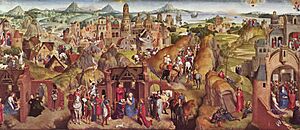Advent and Triumph of Christ facts for kids

Advent and Triumph of Christ is a famous oil painting created around 1480 by Hans Memling. He was a German artist who became a well-known Early Netherlandish painter. This means he was part of an important art movement in the Netherlands during the 15th century.
The painting was originally made for the altar of a church in Bruges, Belgium. It was ordered by the Tanners' guild, which was a group of people who worked with animal hides to make leather. Today, you can see this artwork at the Alte Pinakothek museum in Munich, Germany.
This special painting shows 25 different moments from the life of Jesus. It tells a story without one main scene dominating the picture. Instead, many events are shown together in one large image. These events include:
- The Annunciation, when an angel told Mary she would have a baby.
- The Annunciation to the shepherds, when angels told shepherds about Jesus' birth.
- The Nativity, which is the birth of Jesus.
- The Massacre of the Innocents, a sad event where young children were harmed.
- The Adoration of the Magi, when wise men visited baby Jesus.
- The Passion, which refers to Jesus' suffering and death.
- The Resurrection, when Jesus came back to life.
- The Ascension, when Jesus went up to heaven.
- Pentecost, when the Holy Spirit came to Jesus' followers.
- The Dormition and Assumption of Mary, which are events related to Mary, Jesus' mother.
Memling used a similar storytelling style in another painting called Scenes from the Passion of Christ. He painted that one around 1470 for a man named Tommaso Portinari. That earlier painting is now in the Galleria Sabauda in Turin, Italy.
See also
 In Spanish: Advenimiento y triunfo de Cristo para niños
In Spanish: Advenimiento y triunfo de Cristo para niños

